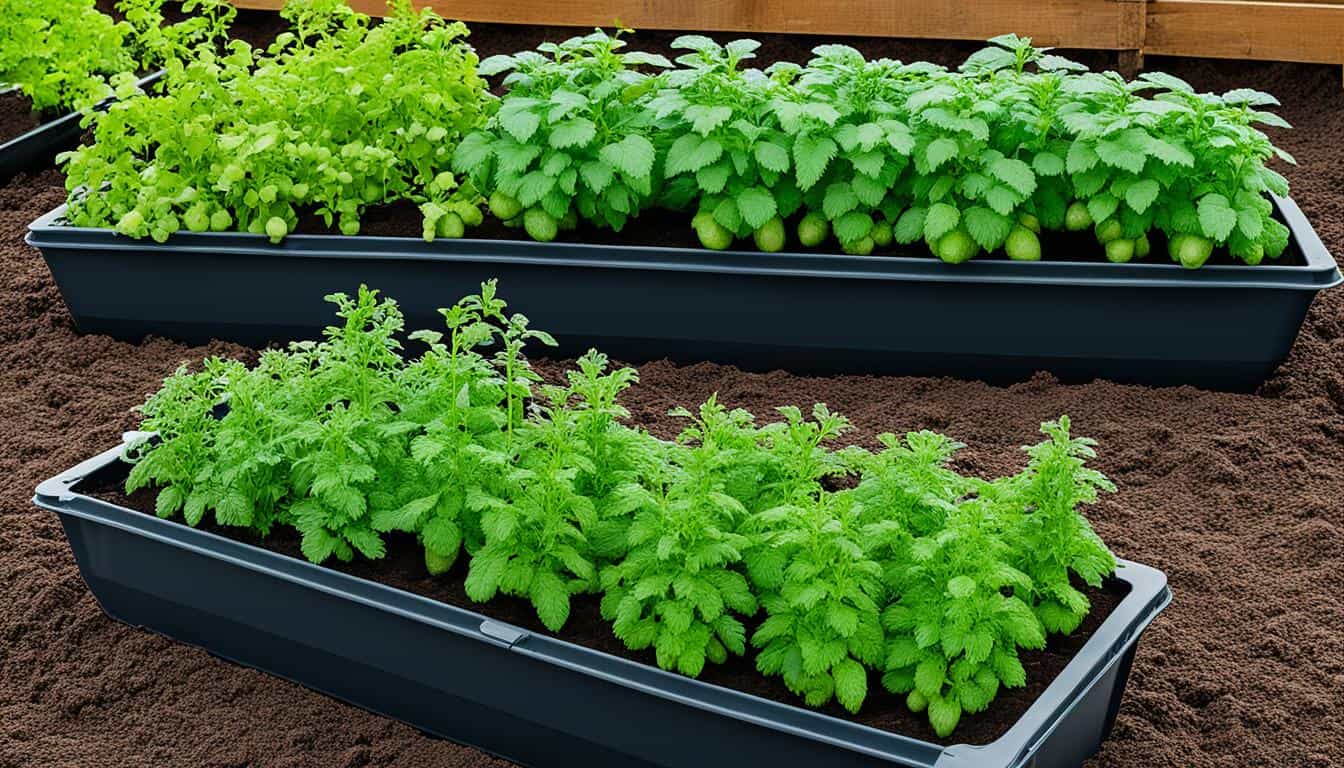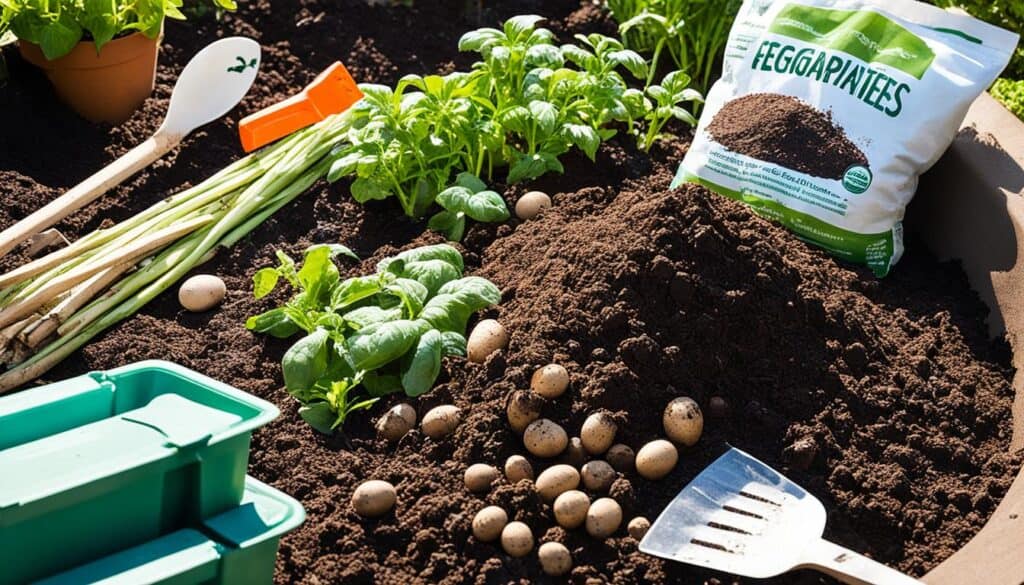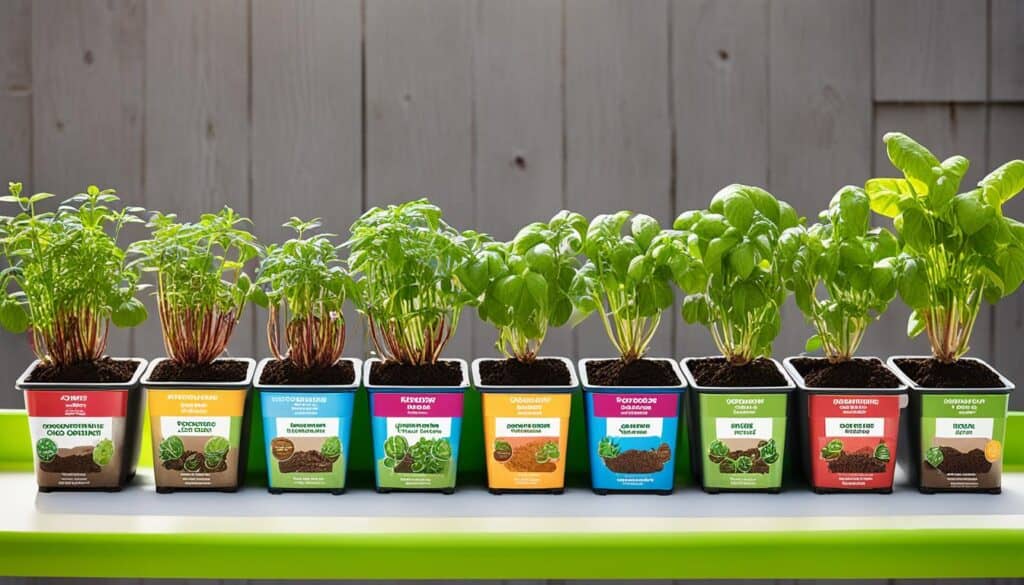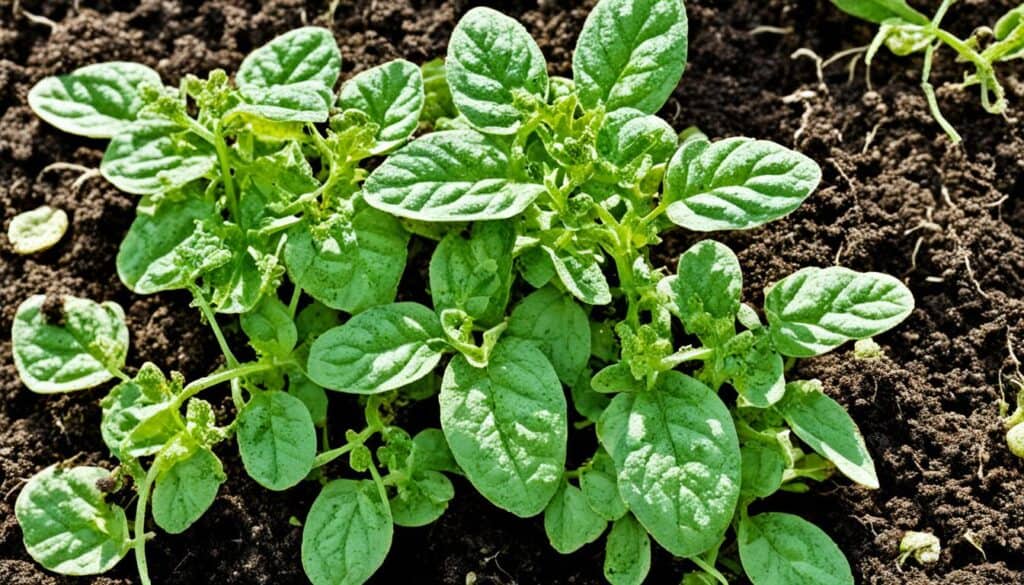Did you know that you can easily grow your own potatoes, even if you have limited garden space? By planting potatoes in containers, you can enjoy a bountiful harvest of fresh and delicious spuds right from your own patio or balcony. Container gardening potatoes has become a popular practice, providing a convenient and space-saving solution for potato enthusiasts.
Key Takeaways
- Planting potatoes in containers is a convenient and space-saving way to grow your own spuds.
- Container gardening potatoes allows you to enjoy fresh and delicious potatoes, even with limited garden space.
- By following simple steps, such as hilling up the soil and using high-quality potting soil, you can successfully grow potatoes in pots.
- Choosing the right containers with good drainage is essential for successful potato container gardening.
- Regular watering and proper care are crucial for ensuring a healthy and productive potato harvest.
Benefits of Growing Potatoes in Containers
Growing potatoes in containers offers several advantages. First, it allows you to protect your plants from pests like voles and wireworms. Additionally, it is a great option for those with limited garden space or rocky soil. You can choose from a variety of potato varieties that are suitable for container gardening, and the size of the container will depend on the number of plants you want to grow. It is important to ensure that the containers have good drainage to prevent waterlogging.
One of the key benefits of container planting potatoes is the ability to protect your plants from unwanted pests. Voles and wireworms, for example, can wreak havoc on your potato crop. By growing potatoes in containers, you can create a barrier between your plants and these pesky critters, reducing the risk of damage and ensuring a healthier harvest.
“Container gardening is an excellent solution for gardeners with limited outdoor space or those dealing with rocky or poor-quality soil. It allows you to grow potatoes in a controlled environment, providing the optimal conditions for your plants to thrive.”
Another advantage of container gardening is the flexibility it offers in terms of potato varieties. You can choose from a wide range of potato varieties specifically bred for container gardening. Some popular options include Yukon Gold, Red Thumb, and Purple Majesty. These varieties have compact growth habits and perform well in the restrained environment of containers.
The size of the container is an important consideration when growing potatoes. The container should be large enough to accommodate the potato plants and allow room for the development of healthy roots. As a general rule, each potato plant requires a container with a capacity of at least 5 gallons. A larger container will be suitable for growing multiple plants.
Potato Container Size Guide
| Number of Potato Plants | Container Size |
|---|---|
| 1-2 plants | 5-gallon container |
| 3-4 plants | 10-gallon container |
| 5 or more plants | 20-gallon container or larger |
It is crucial to ensure that the containers used for potato planting have good drainage. Excess moisture can lead to waterlogged soil, which increases the risk of diseases and root rot. Make sure the containers have drainage holes at the bottom to allow excess water to escape. You can also add a layer of gravel or stones at the bottom of the container to improve drainage.
With the benefits of pest protection, space-saving, and variety options, growing potatoes in containers is an excellent choice for any gardener. Follow the recommended container sizes and ensure proper drainage to create a favorable environment for your potato plants.
Choosing the Right Containers for Potatoes
When it comes to growing potatoes in containers, selecting the right containers is key to ensuring optimal growth and a bountiful harvest. Let’s take a closer look at the best containers for growing potatoes:
- Fabric Potato Grow Bags: Fabric potato grow bags are a popular choice among container gardeners. They are lightweight, provide excellent drainage, and are available in various sizes. The fabric material allows for proper aeration of the roots, promoting healthy growth.
- Plastic Buckets and Bins: If you prefer a more traditional option, plastic buckets and bins can also be used to grow potatoes. However, make sure that these containers have proper drainage holes to prevent waterlogging that can lead to root rot.
- Avoid Harmful Materials: It is important to avoid using containers made from materials that may contain harmful chemicals, such as old tires. These materials can leach toxins into the soil, potentially harmful to both the environment and your health.
When selecting containers, consider the size based on the number of potato plants you plan to grow. Containers with a depth of 2 to 3 feet are ideal, allowing ample room for the roots to develop and the plants to flourish.
Preparing the Soil and Fertilizing
When it comes to growing healthy and productive potatoes in containers, preparing the soil and providing the right nutrients are crucial. Here are some essential steps to follow:
Choosing High-Quality Potting Soil
To ensure optimal growth, it’s important to use a high-quality potting soil. Look for a fast-draining mix that is preferably organic. Avoid using garden soil as it can contain pathogens and weed seeds that may hinder the growth of your potatoes.
Adding Well-Composted Organic Matter
Mixing in well-composted organic matter is a great way to provide essential nutrients to your potato plants. Compost adds valuable organic matter to the soil, improving its structure and enhancing its ability to retain moisture and nutrients. Simply mix the compost into the potting soil before planting your potatoes.
Incorporating Slow-Release Organic Fertilizer
In addition to organic matter, incorporating a slow-release organic fertilizer into the soil before planting can provide a steady supply of nutrients throughout the growing season. This will ensure that your potatoes have everything they need for healthy growth and development.
Feeding with Diluted Liquid Organic Fertilizer
As your potato plants continue to grow, it’s important to provide them with additional nutrients to support their development. Regularly feeding your potatoes with a diluted liquid organic fertilizer every few weeks will help ensure they receive adequate nutrition. This is particularly important during periods of rapid growth and tuber formation.
Remember to follow the instructions on the fertilizer package carefully, as over-fertilizing can be detrimental to your plants. Always dilute the fertilizer according to the recommended ratios to prevent burning the roots or causing nutrient imbalances.
By preparing the soil with high-quality potting soil, incorporating organic matter and slow-release fertilizer, and providing regular doses of liquid organic fertilizer, you can give your container-grown potatoes the best chance of thriving and producing a bountiful harvest.
| Key Steps: | Benefits: |
|---|---|
| Use high-quality potting soil | – Ensures good drainage and prevents soil-borne diseases |
| Add well-composted organic matter | – Improves soil fertility and moisture retention |
| Incorporate slow-release organic fertilizer | – Provides steady nutrients throughout the growing season |
| Feed with diluted liquid organic fertilizer | – Supplies additional nutrients for healthy growth and tuber formation |
Planting and Caring for Potato Plants
Once you have your containers ready and the soil prepared, it’s time to plant your potato plants and start caring for them. Here’s a step-by-step guide on how to successfully grow potatoes in pots:
- Prepare your seed potatoes: Begin by selecting high-quality seed potatoes. You can either cut them into chunks, making sure each piece has at least two eyes, or plant them whole if they are small enough. Cutting the potatoes allows you to maximize the number of plants you can grow.
- Position the seed potatoes: Place the seed potatoes onto the potting soil in the containers, ensuring that the eyes are facing up. Space them out evenly, leaving enough room for the plants to grow and spread.
- Cover and water: Gently cover the seed potatoes with a couple of inches of soil. Then, give them a thorough watering to ensure the soil is moist. It’s important to strike a balance between keeping the soil consistently moist and avoiding waterlogging.
- Select a sunny spot: Position the containers in a sunny spot that receives a minimum of six hours of direct sunlight per day. Potatoes thrive in full sun, so providing them with ample light is crucial for their growth and productivity.
- Regular watering: Water your potatoes regularly, keeping the soil consistently moist. Check the moisture level by inserting your finger into the soil up to the second knuckle. If it feels dry, it’s time to water. Be sure to water deeply, allowing the moisture to reach the roots.
- Mound soil and encourage growth: As the potato plants grow, continue to mound soil around the stems. This process, known as hilling up, helps protect the tubers from exposure to light, preventing them from turning green. It also encourages more potatoes to develop, resulting in a higher yield.
By following these steps and providing your potato plants with the necessary care, you’ll be on your way to a successful harvest. Now, let’s take a closer look at the various stages of potato growth and how to monitor and nurture your plants along the way.
Monitoring Potato Growth Stages
Throughout the growing season, it’s essential to monitor the progress of your potato plants. By observing their growth stages, you can address any issues promptly and ensure optimal conditions for your crops. Here are the key stages to watch out for:
| Growth Stage | Description |
|---|---|
| Sprouting | The emergence of green shoots from the planted seed potatoes. |
| Vegetative Growth | Rapid increase in foliage, with leaves forming a dense canopy. |
| Flowering | Appearance of vibrant flowers, typically white, pink, or purple in color. |
| Tubers Formation | The swelling and development of potato tubers underground. |
| Maturation | Completion of tuber development, as indicated by the dying back of foliage. |
| Harvest | The process of digging up the mature potatoes from the containers. |
By recognizing each growth stage, you can tailor your care and provide the appropriate support needed for optimal potato development.
Now that you understand how to plant and care for your potato plants, it’s time to move on to the exciting phase of harvesting and storing your homegrown spuds. Section 6 will guide you through the process, ensuring you get the most out of your container-grown potatoes.
Harvesting and Storing Potatoes
Once your potato plants have flowered, it’s time to harvest those delicious tubers. Harvesting can be done when the plants have died back completely or when they are still flowering, allowing you to enjoy some new potatoes before the full harvest. To start, gently reach into the soil of the containers and carefully pull out a few new potatoes at a time. Make sure not to damage the plant or disturb the other tubers.
If you prefer to wait for the full harvest, let the plants die back naturally. Once the foliage has withered and turned yellow, you can harvest all the potatoes at once. Use a garden fork or your hands to gently loosen the soil and carefully remove the potatoes.
To store your harvested potatoes, it’s important to prepare them properly. First, brush off any excess dirt, but do not wash them, as moisture can cause premature sprouting. Allow the potatoes to dry for a couple of days in a well-ventilated area. This helps toughen their skin and prolong their storage life.
For optimal storage, use baskets or paper bags that allow for airflow and prevent moisture buildup. Avoid using plastic bags or sealed containers, as these can trap moisture and promote rot. Store the potatoes in a cool, dark place with a consistent temperature of around 45-50°F (7-10°C). Avoid storing them near onions or apples, as these can accelerate spoilage.
Remember to check your stored potatoes regularly for any signs of decay or sprouting. Remove any spoiled potatoes promptly to prevent the spread of rot. With proper harvesting and storage practices, you can enjoy homegrown potatoes for several months after harvest.
Planting Potatoes in Containers: Tips and Tricks
When it comes to planting potatoes in containers, a little extra care and attention can go a long way in ensuring a successful harvest. Here are some helpful tips and tricks to maximize your potato-growing success:
Use Fresh Soil and Compost
To provide the best growing conditions for your potatoes, start with fresh potting soil each year. This ensures that the soil is nutrient-rich and free from potential pathogens and weed seeds. Additionally, incorporate well-composted organic matter into the soil to provide essential nutrients for the potatoes to thrive.
Avoid Overcrowding
It’s important not to overcrowd your containers when planting potatoes. This can lead to competition for resources and stunted growth. Instead, plant a single layer of seed potatoes, making sure to space them out evenly. This allows each plant to have sufficient space for root development and encourages optimal growth.
Monitor Soil Moisture
Consistent moisture is crucial for the successful growth of potatoes in containers. Regularly monitor the moisture level of the soil and water accordingly. Keep in mind that containers can dry out more quickly than garden beds, so you may need to water more frequently, especially during hot and dry periods. Aim for consistent moisture without overwatering, as waterlogged soil can lead to root rot.
Hill up the Soil
As your potato plants grow, it’s important to hill up the soil around the stems. This involves adding more soil to the containers, covering the lower part of the stems. Hilling up the soil helps protect the developing tubers from exposure to light, preventing them from turning green and becoming bitter. It also promotes the formation of additional tubers along the buried stems.
Consider Organic Fertilizers and Companion Plants
Organic fertilizers can be beneficial for potato plants in containers. Consider using slow-release organic fertilizers or organic liquid fertilizers to provide a steady supply of nutrients throughout the growing season. Additionally, certain companion plants, such as marigolds and basil, can help deter pests and promote healthy growth in your potato containers.
Remember, each potato variety and growing environment is unique, so don’t be afraid to experiment and adapt these tips to suit your specific conditions. With a bit of patience and care, you’ll be enjoying a bountiful harvest of homegrown potatoes in no time!
Image:
Growing Potatoes Indoors during Winter
During the winter months, you can continue to enjoy fresh and homegrown potatoes by growing them indoors. With the right conditions and care, you can have a successful indoor potato garden. Whether you have a greenhouse or a sunny window, there are options available to meet your needs.
If you have a greenhouse, it provides an ideal environment for growing potatoes during winter. The controlled temperature and ample sunlight create optimal conditions for plant growth. Place your potato containers in the greenhouse, ensuring they receive at least six hours of direct sunlight each day. Monitor the temperature to ensure it stays within the ideal range for potato cultivation.
For those without a greenhouse, a sunny window can serve as an alternative location for your indoor potato garden. Choose a window that receives the most sunlight throughout the day. Place your potato containers near the window, ensuring they get maximum exposure to sunlight. Remember to rotate the containers periodically, so all sides of the plants receive equal sunlight.
Note: If natural light is limited, you can supplement it by using grow lights. Choose full spectrum LED grow lights and position them appropriately to provide consistent and adequate light for your potato plants.
The process of growing potatoes indoors during winter is similar to growing them outdoors. However, you need to make adjustments to accommodate the indoor conditions. Monitor the moisture level of the soil and water as needed to keep it consistently moist. Indoor environments tend to be drier, so regular watering is essential. Be careful not to overwater, as it can lead to root rot.
Just like outdoor potatoes, indoor potatoes also require proper nutrition. Provide them with a balanced fertilizer specifically formulated for vegetables. Follow the packaging instructions for application rates and frequency. Regularly check the nutrient levels and adjust the fertilization accordingly.
By growing potatoes indoors during winter, you can continue to enjoy a fresh supply of homegrown spuds. Remember to provide adequate heat and light, monitor the moisture level, and provide the necessary nutrients. With proper care and attention, you can have a successful and rewarding indoor potato garden all year round.
Common Issues and Solutions for Container-Grown Potatoes
Container-grown potatoes can sometimes face challenges from potato pests and diseases. It’s important to be aware of these common potato problems and take appropriate measures to prevent and manage them.
Potato Pests
One of the most common pests that affect container-grown potatoes is the potato beetle. These beetles feed on the leaves of the plants and can quickly defoliate them if left uncontrolled. To prevent potato beetle infestations, consider using beneficial nematodes, which are microscopic worms that prey on the larvae of the beetles. This natural form of pest control can help keep your potato plants healthy and thriving.
Common Potato Diseases
Another issue that container-grown potatoes may encounter is common scab, a soil-borne disease caused by a bacterium. It can cause rough, scaly patches on the skin of the potatoes, making them unappealing and sometimes affecting their taste. To prevent common scab, it’s important to choose potato varieties that are resistant to this disease. Look for scab-resistant varieties when selecting seed potatoes to ensure a higher chance of success.
Soil Drainage and Watering
Proper soil drainage is essential for preventing disease problems in container-grown potatoes. Ensure that your containers have sufficient drainage holes to allow excess water to escape. This will help prevent waterlogged soil, which can create ideal conditions for diseases to thrive. Additionally, regular watering with a focus on maintaining consistent moisture levels can help keep your potato plants healthy and less susceptible to diseases.
Regular Monitoring
To catch and address pests and diseases early on, it’s crucial to regularly monitor your container-grown potato plants. Keep an eye out for any signs of pests, such as chewed leaves or clusters of orange eggs on the undersides of leaves. Similarly, watch for any signs of disease, such as unusual spots or rotting patches on the potato plants. Promptly taking action and implementing appropriate solutions like organic pest control methods or disease-resistant varieties can help prevent further damage and ensure the success of your potato crop.
Recommended Resources for Container Gardening
If you are looking for more information and resources on container gardening, there are several websites and blogs that provide valuable insights and tips. Here are some recommended resources to help you with your container gardening journey:
Garden Blogs
- Learn Landscape
- Organic Kitchen Gardening
“Container gardening is a fantastic way to grow vegetables, and these blogs offer helpful guidance and inspiration to get you started.”
University Websites
- Cornell University
- University of New Hampshire
“These university websites provide more specific information on growing potatoes in containers, including guides and research-backed advice.”
Exploring these resources will provide you with a wealth of knowledge on container gardening techniques, potato planting guides, and expert recommendations to help you successfully grow your own potatoes. Whether you are a beginner or an experienced gardener, these resources will equip you with the information you need to create a thriving container garden.
| Website | Description |
|---|---|
| Learn Landscape | A blog that offers helpful guidance and inspiration for growing vegetables in containers. |
| Organic Kitchen Gardening | A blog focused on organic gardening methods, including container gardening tips. |
| Cornell University | A university website with detailed information on growing potatoes in containers and other gardening resources. |
| University of New Hampshire | The University of New Hampshire’s extension website provides specific guides and research on container gardening potatoes. |
Conclusion
Planting potatoes in containers is an incredibly rewarding gardening project that can be done in any space, no matter how small. By following the recommended steps and tips I have provided, you will be able to successfully grow your own potatoes and savor the taste of fresh, homegrown spuds. Whether you have a balcony, a tiny garden, or even just a sunny window, you can embark on this delightful adventure.
Experimenting with different potato varieties and container sizes allows you to find what works best for you. Discover the joy of growing your favorite potato varieties and relish the satisfaction of harvesting them right from your own patio or kitchen. The versatility of container gardening opens up a world of possibilities for every potato lover.
So, whether you’re a seasoned gardener or just starting out, I encourage you to give growing potatoes in containers a try. It’s a fun and rewarding way to connect with nature, enjoy the fruits of your labor, and experience the true taste of freshly dug potatoes. Happy potato gardening!










Leave a Reply